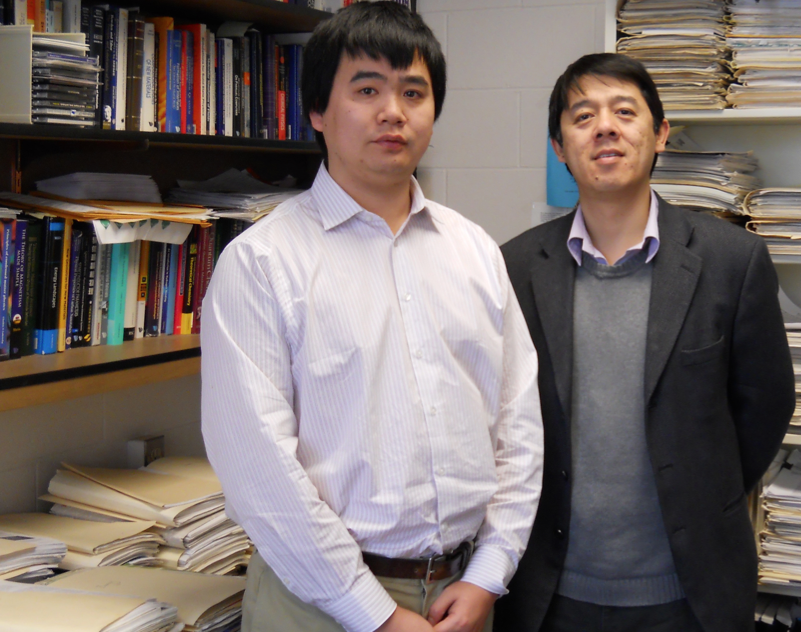
Water is the most abundant liquid on Earth, but the more scientists study it, the more surprises they seem to find. That's nowhere more true than with UNL's Xiao Cheng Zeng and his collaborators.
A pioneer in the study of one-dimensional ice, Zeng with his team at UNL used supercomputers 10 years ago to model four types of one-dimensional ice. Three of the four were subsequently confirmed in laboratory experiments elsewhere in the world and received the scientific designations of one-dimensional ices I, II and III as the first three to be confirmed. Later, one-dimensional ice IV, V and VI were discovered by other groups in the world.
Now it appears that Zeng's UNL team in collaboration with a group at Xiamen University in China led by La-Sheng Long may have found a surprising seventh one-dimensional ice - surprising because it has unexpected ferroelectric properties similar to those in ferroelectric materials that have broad applications in microelectronics, computers and transducers.
In research published in the Feb. 14-18 online edition of the Proceedings of the National Academy of Sciences, the Xiamen and UNL scientists found that water molecules in a channel with a diameter of just less than 1-nanometer diameter (1 billionth of a meter) freeze spontaneously at 37 degrees Fahrenheit into an ice "wire" with distinct positive and negative poles (known as a net dipole moment).
Every water molecule has a dipole moment, with its oxygen atom possessing a bit more negative charge and its hydrogen atoms having a bit more positive charge. In bulk ice or water, like that in a lake, stream or ice cube, the dipoles are all randomly oriented and the water has no net dipole moment. That's not the case with the new one-dimensional ice, though.
"That the water molecules can align their dipole moments in an ordered fashion is very amazing," said Zeng, university professor and Ameritas professor of chemistry. "We don't know why, but Mother Nature somehow allows the water molecules to orient this way and (the wire) could be very long. That's very surprising. The second surprise is their (liquid-to-ice) transition temperature is so close to the freezing temperature of normal ice."
Zeng said there was a reversal of roles in this recent research compared to his work of 10 years ago. Back then, his lab predicted new ice forms through computational modeling and waited for laboratory confirmation. This time, the Xiamen scientists performed the laboratory experiments first and asked Zeng if his lab could conduct computer simulations to further characterize the ice. Hui Li, a postdoctoral researcher in Zeng's lab and one of the first co-authors of the PNAS paper, devised computational experiments to run on UNL's Holland supercomputer and confirmed the finding.
"Ten years ago, the Nebraska group started the field pretty much," Zeng said. "Now, a lot of people know the work we do on nano ice and they come to us to collaborate.
"With this group in China, we didn't know each other before this collaboration, but it is a beautiful example of international collaboration between a computational group and a hands-on experimental group."
Prior to these experiments, existence of ferroelectric ice with partial ferroelectric alignment had been demonstrated only with thin, two-dimensional films of ice grown on platinum surfaces and in three-dimensional ice with the aid of potassium hydroxide "doping" and extremely low temperatures. Ferroelectric three-dimensional ice is suspected to exist on the solar system's outer planets and theoretically could exist on Earth due to water's inherent dipolarity - but its formation would be anything but spontaneous. Scientists estimate it would take 10,000 years at minus-330 degrees Fahrenheit for normal ice to transform unaided into ferroelectric ice (known as three-dimensional ice XI).
The UNL group's work on this research was supported by the National Science Foundation, the Army Research Office, the Nebraska Research Initiative and the University of Nebraska's Holland Computing Center.
It's the eighth time in 10 years that research from Zeng's lab has been published in one of the three highest-impact interdisciplinary journals, Nature, Science and PNAS.
- Tom Simons, University Communications